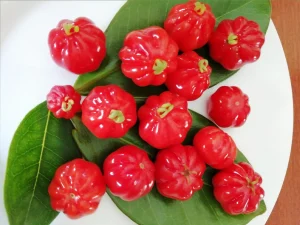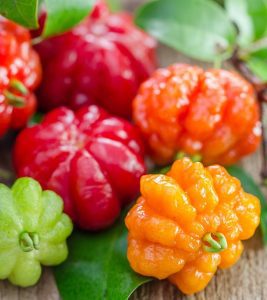Surinam Cherry (Eugenia uniflora) Facts About This Fruit

The Surinam cherry, also known as Eugenia uniflora or pitanga, is a tropical fruit native to Africa and South America. Here are some key points about it:
- Description: It’s a large shrub or small tree that can grow up to 8 meters high. The leaves have a spicy resinous fragrance and the fruit is a botanical berry that ranges from sweet to sour.
- Culinary Uses: The fruit is used as a flavouring and base for jams and jellies. It’s high in vitamin C and a source of provitamin A.
- Medical Uses: While not detailed in the search results, fruits like the Surinam cherry are often recognized for their antioxidant properties.
- Invasive Species: In some regions, like Bermuda and Florida, the Surinam cherry is considered invasive due to its ability to displace native flora
Health benefits of Surinam Cherry (Eugenia uniflora)
nutritional value and how it can positively impact your well-being:
- Rich in Vitamins and Antioxidants:
- Vitamin C: Surinam cherries are notably rich in vitamin C, a vital nutrient known for its immune-boosting properties and its role in promoting healthy skin.
- Antioxidants: These cherries contain a plethora of free-radical-fighting compounds, including quercetin, anthocyanins, and flavonoids. These antioxidants help protect cells from oxidative stress, contributing to overall well-being.
- Essential Minerals and Dietary Fiber:
- Potassium: Surinam cherries provide essential minerals like potassium, which are crucial for maintaining healthy blood pressure and supporting heart function.
- Dietary Fiber: These exotic fruits offer a decent amount of dietary fibre, aiding in regulating bowel movements, preventing constipation, and promoting a feeling of fullness.
- Low-Calorie and Low-Fat Choice:
- For those mindful of their calorie intake, Surinam cherries are an ideal option, as they are remarkably low in calories.
- Traditional Medicinal Uses:
- In traditional medicine, the Eugenia uniflora (Surinam cherry tree) is used to:
- Lower blood pressure
- Prevent heartburn
- Treat conditions such as bronchitis, colic, and stomachaches
- The tea leaves are also used to treat diabetes and possess antirheumatic, anti-dysenteric, and febrifuge qualities.
- In traditional medicine, the Eugenia uniflora (Surinam cherry tree) is used to:
- Beyond the Kitchen:
- Within its native range, Surinam cherry is used in various ways:
- The leaves are scattered on floors to repel flies when stepped upon.
- Medicinally, the leaves are used to stop bleeding, relieve stomach aches, break fevers, and treat colds
- Within its native range, Surinam cherry is used in various ways:
How to Use Surinam Cherry as a Herbal Medicine

Eugenia uniflora is a delightful fruit with a unique flavour. Let’s explore how you can enjoy it:
- Fresh and Simple:
- Eating Fresh: When Surinam cherries are dark red and slightly soft, they are at their best. Simply eat them fresh by removing the seeds. Children often enjoy them this way.
- Juicing: To make Surinam cherry juice, cut the cherries in half, discard the seeds, and place the fruit in a juicer or blender. Strain the juice over a bowl. You can use this juice for making jelly or as a refreshing drink.
- Cooking and Culinary Uses:
- Sauces and Jellies: Surinam cherries can be used to make flavorful sauces. Try this Surinam Cherry Sauce for Chicken, Duck, or Pork:
- Ingredients:
- 2 cups Surinam cherry juice
- ¼ cup raw sugar
- ¼ cup cognac
- 2 shallots, finely minced and sautéed in 1 tablespoon of butter or olive oil
- 2 tablespoons pink peppercorns
- Pinch of salt to taste
- Instructions:
- Simmer the cherry juice and sugar for about 15 minutes.
- Add cognac, salt, and peppercorns; continue reducing on low heat, uncovered, until the consistency resembles maple syrup.
- Serve over sautéed or grilled chicken, duck, or pork.
- Ingredients:
- Salads: Add Surinam cherries to fruit salads for a burst of tangy flavor.
- Wine: Brazilians even make wine with these cherries.
- Sauces and Jellies: Surinam cherries can be used to make flavorful sauces. Try this Surinam Cherry Sauce for Chicken, Duck, or Pork:
- Caution:
- Toxic Seeds: Do not eat the seeds, as they are toxic.
- Fun and Delicious:
- Give this exotic fruit a try! Whether you enjoy it fresh, as a sauce, or in creative recipes, Surinam cherries are a delightful addition to your culinary adventures.
Side Effects of Surinam Cherry
- While these cherries are celebrated for their exceptional taste and potential health benefits, it is crucial to be aware of the possible side effects that consuming them may entail:
- Gastrointestinal Distress: Consuming Surinam cherries in excessive quantities can lead to gastrointestinal distress.
- Allergic Reactions: Some individuals may experience allergic reactions, resulting in hives, itching, and swelling.
- Hyperacidity: Surinam cherries may exacerbate hyperacidity in sensitive individuals.
- Tooth Sensitivity: The fruit’s acidity could potentially affect tooth sensitivity.
- Interference with Mineral Absorption: Surinam cherry contains oxalates, which can interfere with the absorption of certain minerals, such as calcium.
References
How to Use the Surinam Cherry
Side Effects of Surinam Cherry
Chemical Properties of Surinam Cherry
More links

